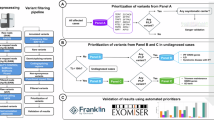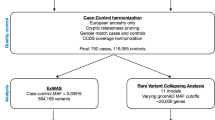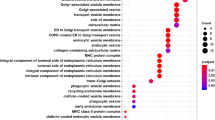Abstract
Idiopathic pulmonary fibrosis (IPF) is an age-related disease featuring progressive lung scarring. To elucidate the molecular basis of IPF, we performed exome sequencing of familial kindreds with pulmonary fibrosis. Gene burden analysis comparing 78 European cases and 2,816 controls implicated PARN, an exoribonuclease with no previous connection to telomere biology or disease, with five new heterozygous damaging mutations in unrelated cases and none in controls (P = 1.3 × 10−8); mutations were shared by all affected relatives (odds in favor of linkage = 4,096:1). RTEL1, an established locus for dyskeratosis congenita, harbored significantly more new damaging and missense variants at conserved residues in cases than in controls (P = 1.6 × 10−6). PARN and RTEL1 mutation carriers had shortened leukocyte telomere lengths, and we observed epigenetic inheritance of short telomeres in family members. Together, these genes explain ∼7% of familial pulmonary fibrosis and strengthen the link between lung fibrosis and telomere dysfunction.
This is a preview of subscription content, access via your institution
Access options
Subscribe to this journal
Receive 12 print issues and online access
$209.00 per year
only $17.42 per issue
Buy this article
- Purchase on SpringerLink
- Instant access to full article PDF
Prices may be subject to local taxes which are calculated during checkout




Similar content being viewed by others
Accession codes
References
Travis, W.D. et al. An official American Thoracic Society/European Respiratory Society statement: update of the international multidisciplinary classification of the idiopathic interstitial pneumonias. Am. J. Respir. Crit. Care Med. 188, 733–748 (2013).
Raghu, G. et al. An official ATS/ERS/JRS/ALAT statement: idiopathic pulmonary fibrosis: evidence-based guidelines for diagnosis and management. Am. J. Respir. Crit. Care Med. 183, 788–824 (2011).
Fingerlin, T.E. et al. Genome-wide association study identifies multiple susceptibility loci for pulmonary fibrosis. Nat. Genet. 45, 613–620 (2013).
Armanios, M.Y. et al. Telomerase mutations in families with idiopathic pulmonary fibrosis. N. Engl. J. Med. 356, 1317–1326 (2007).
Tsakiri, K.D. et al. Adult-onset pulmonary fibrosis caused by mutations in telomerase. Proc. Natl. Acad. Sci. USA 104, 7552–7557 (2007).
Diaz de Leon, A. et al. Telomere lengths, pulmonary fibrosis and telomerase (TERT) mutations. PLoS ONE 5, e10680 (2010).
Kropski, J.A. et al. A novel dyskerin (DKC1) mutation is associated with familial interstitial pneumonia. Chest 146, e1–e7 (2014).
Parry, E.M. et al. Decreased dyskerin levels as a mechanism of telomere shortening in X-linked dyskeratosis congenita. J. Med. Genet. 48, 327–333 (2011).
Nogee, L.M. et al. A mutation in the surfactant protein C gene associated with familial interstitial lung disease. N. Engl. J. Med. 344, 573–579 (2001).
Thomas, A.Q. et al. Heterozygosity for a surfactant protein C gene mutation associated with usual interstitial pneumonitis and cellular nonspecific interstitial pneumonitis in one kindred. Am. J. Respir. Crit. Care Med. 165, 1322–1328 (2002).
Wang, Y. et al. Genetic defects in surfactant protein A2 are associated with pulmonary fibrosis and lung cancer. Am. J. Hum. Genet. 84, 52–59 (2009).
Cronkhite, J.T. et al. Telomere shortening in familial and sporadic pulmonary fibrosis. Am. J. Respir. Crit. Care Med. 178, 729–737 (2008).
Marshall, R.P., Puddicombe, A., Cookson, W.O. & Laurent, G.J. Adult familial cryptogenic fibrosing alveolitis in the United Kingdom. Thorax 55, 143–146 (2000).
Petrovski, S., Wang, Q., Heinzen, E.L., Allen, A.S. & Goldstein, D.B. Genic intolerance to functional variation and the interpretation of personal genomes. PLoS Genet. 9, e1003709 (2013).
Ballew, B.J. et al. A recessive founder mutation in regulator of telomere elongation helicase 1, RTEL1, underlies severe immunodeficiency and features of Hoyeraal Hreidarsson syndrome. PLoS Genet. 9, e1003695 (2013).
Deng, Z. et al. Inherited mutations in the helicase RTEL1 cause telomere dysfunction and Hoyeraal-Hreidarsson syndrome. Proc. Natl. Acad. Sci. USA 110, E3408–E3416 (2013).
Le Guen, T. et al. Human RTEL1 deficiency causes Hoyeraal-Hreidarsson syndrome with short telomeres and genome instability. Hum. Mol. Genet. 22, 3239–3249 (2013).
Walne, A.J., Vulliamy, T., Kirwan, M., Plagnol, V. & Dokal, I. Constitutional mutations in RTEL1 cause severe dyskeratosis congenita. Am. J. Hum. Genet. 92, 448–453 (2013).
Ballew, B.J. et al. Germline mutations of regulator of telomere elongation helicase 1, RTEL1, in dyskeratosis congenita. Hum. Genet. 132, 473–480 (2013).
Vannier, J.B., Pavicic-Kaltenbrunner, V., Petalcorin, M.I., Ding, H. & Boulton, S.J. RTEL1 dismantles T loops and counteracts telomeric G4-DNA to maintain telomere integrity. Cell 149, 795–806 (2012).
Cogan, J.D. et al. Rare variants in RTEL1 are associated with familial interstitial pneumonia. Am. J. Respir. Crit. Care Med. 191, 646–655 (2015).
Stuart, B.D. et al. Effect of telomere length on survival in patients with idiopathic pulmonary fibrosis: an observational cohort study with independent validation. Lancet Respir. Med. 2, 557–565 (2014).
Körner, C.G. et al. The deadenylating nuclease (DAN) is involved in poly(A) tail removal during the meiotic maturation of Xenopus oocytes. EMBO J. 17, 5427–5437 (1998).
Dehlin, E., Wormington, M., Korner, C.G. & Wahle, E. Cap-dependent deadenylation of mRNA. EMBO J. 19, 1079–1086 (2000).
Yoda, M. et al. Poly(A)-specific ribonuclease mediates 3′-end trimming of Argonaute2-cleaved precursor microRNAs. Cell Rep. 5, 715–726 (2013).
Berndt, H. et al. Maturation of mammalian H/ACA box snoRNAs: PAPD5-dependent adenylation and PARN-dependent trimming. RNA 18, 958–972 (2012).
Heiss, N.S. et al. X-linked dyskeratosis congenita is caused by mutations in a highly conserved gene with putative nucleolar functions. Nat. Genet. 19, 32–38 (1998).
Vulliamy, T. et al. Mutations in the telomerase component NHP2 cause the premature ageing syndrome dyskeratosis congenita. Proc. Natl. Acad. Sci. USA 105, 8073–8078 (2008).
Walne, A.J. et al. Genetic heterogeneity in autosomal recessive dyskeratosis congenita with one subtype due to mutations in the telomerase-associated protein NOP10. Hum. Mol. Genet. 16, 1619–1629 (2007).
Alder, J.K. et al. Short telomeres are a risk factor for idiopathic pulmonary fibrosis. Proc. Natl. Acad. Sci. USA 105, 13051–13056 (2008).
Steele, M.P. et al. Clinical and pathologic features of familial interstitial pneumonia. Am. J. Respir. Crit. Care Med. 172, 1146–1152 (2005).
Zaidi, S. et al. De novo mutations in histone-modifying genes in congenital heart disease. Nature 498, 220–223 (2013).
Sanders, S.J. et al. De novo mutations revealed by whole-exome sequencing are strongly associated with autism. Nature 485, 237–241 (2012).
Iossifov, I. et al. De novo gene disruptions in children on the autistic spectrum. Neuron 74, 285–299 (2012).
International HapMap Consortium. A second generation human haplotype map of over 3.1 million SNPs. Nature 449, 851–861 (2007).
Browning, B.L. & Browning, S.R. A fast, powerful method for detecting identity by descent. Am. J. Hum. Genet. 88, 173–182 (2011).
Levy, D. et al. Rare de novo and transmitted copy-number variation in autistic spectrum disorders. Neuron 70, 886–897 (2011).
Olson, J.M. A general conditional-logistic model for affected-relative-pair linkage studies. Am. J. Hum. Genet. 65, 1760–1769 (1999).
Herbert, B.-S., Shay, J.W. & Wright, W.E. in Current Protocols in Cell Biology Vol. 18.6.1–18.6.20 (John Wiley & Sons, Inc., 2003).
Acknowledgements
We are grateful to the probands and their families for their participation, to A. Young for technical excellence, to S. Nolasco, K. Stephens and G. Wools for their help with blood sample collections, to the Yale Center for Genome Analysis for the generation of exome sequence data, and to the Yale Center for Genome Analysis and the McDermott Center Bioinformatics Core for sequence analysis. The authors acknowledge funding support from the following sources: US National Institutes of Health (NIH) National Center for Advancing Translational Sciences grant UL1TR001105; US NIH grant U54HG006504 (to the Yale Center for Mendelian Genomics); the Howard Hughes Medical Institute (R.P.L.); US NIH grant K12HD068369 (B.D.S.); and US NIH grant R01HL093096 (C.K.G.).
Author information
Authors and Affiliations
Contributions
C.K.G., C.X. and R.P.L. conceived, designed and directed the study. J.C., S.Z., C.X., W.J., K.B. and S.M. performed genetic analyses. B.D.S., B.H., R.C., M.C. and J.W.S. performed and directed experiments. P.D., F.T., C.E.G., J.W., J.F., C.K., J.K.-T. and Y.M. contributed clinical evaluations. All authors approved the final manuscript and contributed critical revisions to its intellectual content.
Corresponding author
Ethics declarations
Competing interests
The authors declare no competing financial interests.
Integrated supplementary information
Supplementary Figure 1 Principal-component analysis of probands and controls.
(a) Principal-component analysis of genotypes from exome data of 99 familial pulmonary fibrosis probands demonstrating clustering with HapMap subjects of European (n = 79), Mexican (n = 19) and African-American (n = 1) ancestry. (b) European controls (n = 2,816) sequenced and analyzed by the Yale Center for Genome Analysis showing clustering with HapMap subjects of European ancestry.
Supplementary Figure 2 Reduced PARN expression of mutant mRNA and protein in EBV-transformed lymphoblastoid cell lines.
(a) PCR amplification and sequencing of genomic DNA validated the presence of the heterozygous c.529C>T (p.Gln177*) mutation in the proband of kindred F70 but not in a control DNA sample. RT-PCR from total cDNA demonstrated a lower level of the Gln177* mutant transcript than the wild-type (WT) transcript from an EBV-transformed lymphoblastoid cell line (LCL) derived from the proband of kindred 70. RT-PCR from cDNA isolated from a control LCL is also shown. Control cell lines were derived from mutation-negative individuals from these kindreds. (b) Immunoblot analysis of PARN and tubulin from LCLs derived from control subjects or from different individuals with the indicated heterozygous PARN mutation. (c) Relative PARN expression of each sample shown in b as quantified by ImageJ. *P < 0.05; n.s., not significant.
Supplementary Figure 3 Sanger sequence electropherograms of PCR products amplified from genomic DNA of probands heterozygous for mutations in PARN and RTEL1.
(a) PARN. (b) RTEL1. Wild-type cDNA sequences are listed above the tracings. Heterozygous mutations are indicated at the positions marked by the arrows. Deleted and inserted bases are boxed and result in an overlap of wild-type and mutant sequences. The predicted translated amino acid sequence of the protein (in single-letter amino acid code) and the exon-intron boundaries are indicated above the cDNA sequence.
Supplementary information
Supplementary Text and Figures
Supplementary Figures 1–3 and Supplementary Tables 1–7. (PDF 516 kb)
Rights and permissions
About this article
Cite this article
Stuart, B., Choi, J., Zaidi, S. et al. Exome sequencing links mutations in PARN and RTEL1 with familial pulmonary fibrosis and telomere shortening. Nat Genet 47, 512–517 (2015). https://doi.org/10.1038/ng.3278
Received:
Accepted:
Published:
Issue Date:
DOI: https://doi.org/10.1038/ng.3278



